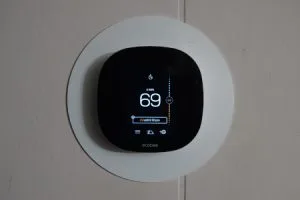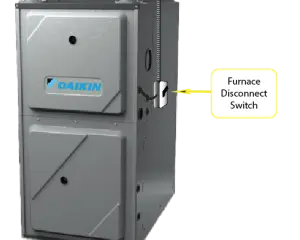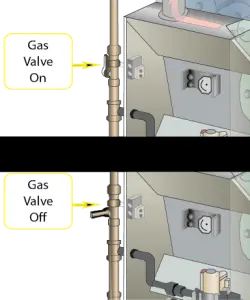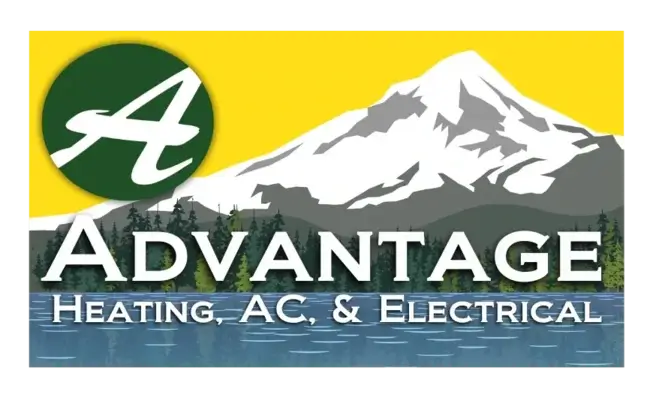7 Reasons Your Furnace Won’t Turn On. Solved!
If your furnace won’t turn on, then you might be in for a pretty uncomfortable cold season. Besides making you miserable, a non-functional furnace can cause health issues or even damage to your property. Therefore, it is critical that you get your furnace up and running as soon as possible.
The good news is that you can fix some of these problems yourself. Other problems you can diagnose yourself. This is important because it allows you to have an educated discussion with your HVAC technician. That way, you can get a more accurate quote for the time and money required.
In this post, we’ll go over 7 of the most common reasons a furnace won’t turn on. We’ll explain how to diagnose or correct them yourself, as well as, how to seek help if it’s something that we can’t recommend you attempt on your own.
Why is it so important to make sure your furnace is working?
Well, for your health and the wellbeing of your property. You can fight the cold for a while with blankets and jackets, but prolonged cold exposure can pose a medical risk. If you live in an area that has severe winters, then staying in an unheated home could pose serious health risks.
Frigid temperatures can also damage your home. The pipes can freeze, resulting in flooding. The cold could also damage the glass of your windows or your home’s frame if it goes on for too long.
If none of the following solutions seem to work for you, then contact your local HVAC pros so you don’t have to deal with any of those problems.
1. The Thermostat isn’t Working
This may seem obvious, but this is a common problem we run into. The thermostat is the piece of equipment that tells your furnace when it’s time to turn on. If your thermostat is not working, then your furnace won’t run.
First, check if your thermostat is:
- On
- Set to Heat
- Set to a Warm Temperature
- Lighting Up its Display

If you have a smart thermostat that connects to your phone, make sure there are no problems with the app. If your thermostat is not coming on, then it could be a problem with wiring, or the thermostat has gone out.
If your thermostat is working, then disable any preset programming and set it to heat only. After you have done that, increase the temperature it’s set to.
Sometimes a thermostat’s programming won’t line up with the actual temperature fluctuations in your home. Telling your thermostat to just heat your home should get hot air flowing, if that is the case.
2. Dirty Air Filter
Air flow problems are one of the most typical issues our technicians run into. The most frequent culprit is the air filter. If air cannot pass through your filter, then your furnace cannot heat your home.
The restricted air flow can overheat your furnace. Most modern furnaces have safety sensors that govern how they run. If your furnace overheats, then those sensors will turn off your furnace.
Check your air filter and see if it is visibly dirty. If it is, then a quick replacement should rectify that problem.
3. Your Furnace Doesn’t Have Power
Another common problem could be that your furnace is not receiving power. As we talked about in a previous post, most furnaces will not work without electricity.
There are three common electrical problems:
- Power Outage
- Disconnect Switch Set to Off
- Flipped Circuit

If you are currently experiencing a power outage, then it is likely that you cannot turn your furnace on. Our suggestion for that scenario is to seek a warming center or get aid, especially if your health is at risk.
If the rest of your home has power, then the furnace disconnect switch may be in the wrong position. Check the switch to your furnace. It sometimes looks like a light switch or a toggle switch in a box next to the furnace.
Make sure it’s set to “on.”
If it is unlabeled, contact the company that installed your furnace. Most commonly, up should be the “on” position.
The last common electrical problem is a blown circuit. Check your circuit breaker and see if a switch flipped. If this is the case, then the issue will need to be resolved by searching for a potential overload.
4. Your Furnace Doesn’t Have Gas
This is another common issue for gas furnaces. Sometimes the gas valve gets left shut.
If your furnace cannot get gas, then it has nothing to ignite to make heat.
Check the gas valve next to your furnace. It should look like a box with a disk, or a lever about the size of a thumb. It normally sits on a gas line somewhere within 6 feet of your furnace. Typically, if the lever is parallel with the gas pipe, then it’s open. If it’s perpendicular, then it’s closed.
If your furnace’s gas valve is open, then check for the same problem at the street side valve. It is not unheard of for utility technicians to leave the valve closed accidentally after servicing the gas main.

If both valves are open, contact your natural gas provider and ask if they are servicing the main in your area or if anyone else has reported a loss of gas. You can also test other gas equipment such as a stove or oven to see if it’s just your furnace or if your entire home is without gas.
If you suspect that there is a gas leak in your home, then please get to safety and call your gas provider or 911 immediately.
5. There Could be Residue on the Flame Sensor
This is where we get to some problems that will require the attention of a qualified HVAC professional.
The flame sensor or ignition sensor is another safety device that monitors your furnace. It detects if a flame is burning and will shut off the furnace if it can’t sense a flame. That way, your furnace does not leak unburnt gas into your home.
As the furnace burns gases to create heat, carbon residue can build up on this sensor. If residue completely obscures the sensor and it cannot detect a flame, then it will not let your furnace turn on.
If you disconnected your furnace, you should be able to see this buildup in the combustion chamber.
There are DIY guides on how to clean it yourself online. However, we recommend that you have a qualified technician do this for you. Improper maintenance on your furnace can void your warranty, leaving you with large repair bills in the future. In the worst case, you could damage the sensor and need to have it replaced.
6. The Blower Motor Could Need Repairs
Another part that could stop working is the motor of the blower fan. This is the fan that blows the air from your furnace through your ducts. If the motor has stopped working, then your furnace cannot push that warm air into your home.
Look to see if your furnace has a glass window to see the blower fan or blower motor. If there is a blinking green light next to the blower, then it will need to be repaired.
7. Your Pilot Light May Not Work
The last common problem could be the pilot light. If the furnace cannot ignite the natural gases, it cannot create heat.
This is another problem that will need to be handled by a qualified HVAC technician. They will reignite or replace your pilot light if need be.
How Can You Prevent These Problems?
Most of the time, a regular tune up could have prevented these problems. During a tune-up, your technician will check the electrical switches and gas flow. They will also check the interior of the furnace to make sure that every sensor and part works as intended. Of course, the technician will also replace the air filter and check the air flow.
However, it is entirely possible that something has gone between the time a technician serviced your furnace and when it stops working. While HVAC technicians do their best, unexpected machine failure can happen to any piece of equipment or appliance.
Who Are Advantage Heating and Air Conditioning, LLC?
We are your local HVAC Experts out of Salem, Oregon. We hope that this post gave you the information you need to know to diagnose why your furnace won’t turn on. If you have other questions about HVAC systems, check out our other blogs. To learn more about who we are and how we can help you, visit our website and follow us on social media – we’re here when you need us!







